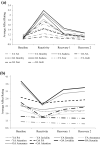Greater negative affect and mixed emotions during spontaneous reactions to sad films in older than younger adults
- PMID: 33746679
- PMCID: PMC7925711
- DOI: 10.1007/s10433-020-00565-8
Greater negative affect and mixed emotions during spontaneous reactions to sad films in older than younger adults
Abstract
Older adults may be better able to regulate emotion responses to negative experiences than younger persons when provided instructions, but age group differences in spontaneous emotion responses are poorly understood. The current study determined age group differences in spontaneous reactivity and recovery in negative and positive affects, as well as the co-occurrence of negative and positive affects, following a laboratory mood induction. Younger (n = 71) and older adults (n = 44) rated negative and positive affects before and several times after a negative mood induction involving sad film clips. ANCOVA and multilevel longitudinal modeling in HLM were utilized to determine age group differences in spontaneous reactivity to and recovery from the mood induction, as well as age group differences in co-occurrence of negative and positive affects. Relative to younger adults, older adults reported greater negative affect reactivity to and recovery from the mood induction. Older adults also reported greater co-occurrence of negative and positive affects in response to the mood induction, as compared to younger adults. Thus, older adults reacted more strongly to sad film clips than younger persons, exhibited efficient recovery, and reported greater co-occurrence of negative and positive affects. A fruitful line of future research might determine whether affect co-occurrence facilitates effective emotion regulation.
Keywords: Affect; Aging; Co-occurrence; Emotion recovery; Mood induction.
© Springer Nature B.V. 2020.
Conflict of interest statement
Conflict of interestThe authors declare that they have no conflict of interest.
Figures



Similar articles
-
Emotional Differences in Young and Older Adults: Films as Mood Induction Procedure.Front Psychol. 2018 Jul 3;9:1110. doi: 10.3389/fpsyg.2018.01110. eCollection 2018. Front Psychol. 2018. PMID: 30018584 Free PMC article.
-
Effects of induced sad mood on facial emotion perception in young and older adults.Neuropsychol Dev Cogn B Aging Neuropsychol Cogn. 2019 May;26(3):319-335. doi: 10.1080/13825585.2018.1438584. Epub 2018 Feb 15. Neuropsychol Dev Cogn B Aging Neuropsychol Cogn. 2019. PMID: 29447561
-
Emotion Regulation and Memory: Differential Associations in Younger and Midlife/Older Adults.Exp Aging Res. 2016;42(3):264-78. doi: 10.1080/0361073X.2016.1156971. Exp Aging Res. 2016. PMID: 27070045
-
Emotional development across adulthood: differential age-related emotional reactivity and emotion regulation in a negative mood induction procedure.Int J Aging Hum Dev. 2007;64(3):217-44. doi: 10.2190/U48Q-0063-3318-1175. Int J Aging Hum Dev. 2007. PMID: 17503687 Clinical Trial.
-
[Mood induction procedures: a critical review].Encephale. 2008 Jun;34(3):233-9. doi: 10.1016/j.encep.2006.08.003. Epub 2008 Jan 22. Encephale. 2008. PMID: 18558143 Review. French.
Cited by
-
Evaluating the Cognitive Effects of Video-Induced Negative Affect in College Students: A Comparative Study between Acute Exercise and Music Listening.J Intell. 2023 Jan 5;11(1):12. doi: 10.3390/jintelligence11010012. J Intell. 2023. PMID: 36662142 Free PMC article.
-
Aging and Mixed Emotions: A Word-Suffix Approach in Free Recall.Behav Sci (Basel). 2023 Feb 12;13(2):160. doi: 10.3390/bs13020160. Behav Sci (Basel). 2023. PMID: 36829389 Free PMC article.
References
-
- Beck AT, Steer RA, Brown GK. Beck Depression Inventory-II (BDI-II) San Antonio: Psychological Corporation; 1996.
LinkOut - more resources
Full Text Sources

